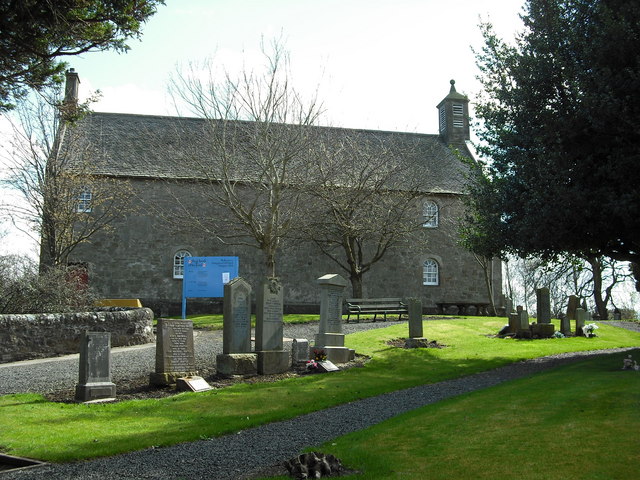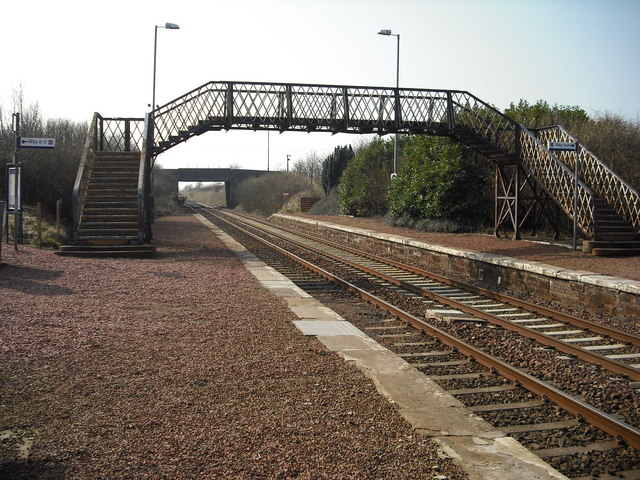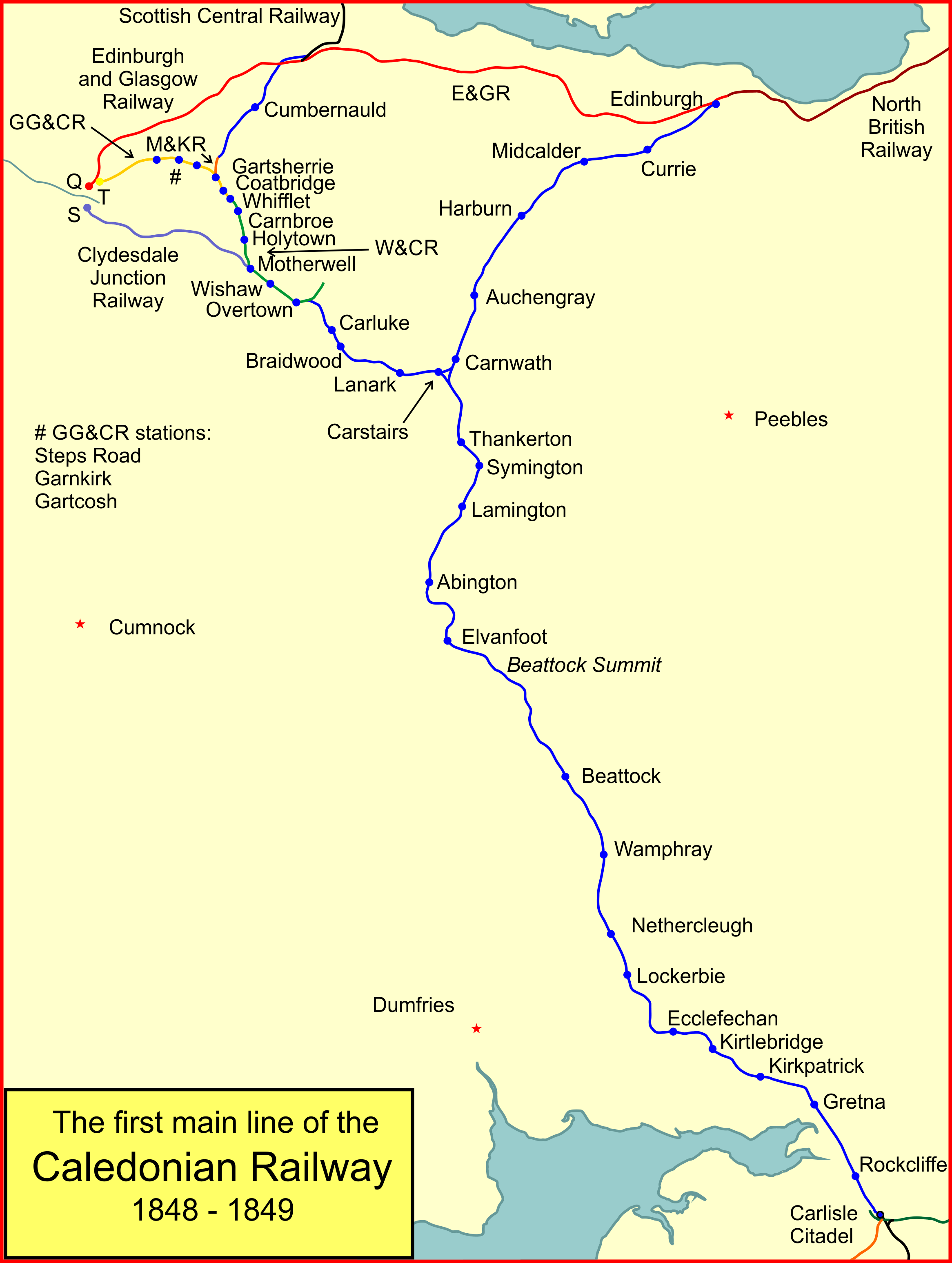|
Newpark Railway Station
Newpark railway station was a railway station serving Newpark near Bellsquarry in West Lothian, then called Linlithgowshire. It was on the Cleland and Midcalder Line between Edinburgh and Glasgow. Trains on the Shotts Line still pass through the site of the former station. History When the Caledonian Railway opened the Cleland and Midcalder Line in 1869, Newpark railway station was the most easterly station on the line around from Mid Calder Junction, with the Caledonian Railway Main Line. It was situated where the Murieston Road crosses over the line.New Popular Edition Maps Once was surrounded by fields, the station site is now on the south west edge Livingston Livingston may refer to: Businesses * Livingston Energy Flight, an Italian airline (2003–2010) * Livingston Compagnia Aerea, an Italian airline (2011–2014), also known as Livingston Airline * Livingston International, a North American custom ..., with housing to the north and south of the station site although ... [...More Info...] [...Related Items...] OR: [Wikipedia] [Google] [Baidu] |
Livingston, Scotland
Livingston ( sco, Leivinstoun, gd, Baile Dhunlèibhe) is the largest town in West Lothian, Scotland. Designated in 1962, it is the fourth post-war new town to be built in Scotland. Taking its name from a village of the same name incorporated into the new town, it was originally developed in the then-counties of Midlothian and West Lothian along the banks of the River Almond. It is situated approximately fifteen miles (25 km) west of Edinburgh and thirty miles (50 km) east of Glasgow, and is close to the towns of Broxburn to the north-east and Bathgate to the north-west. The town was built around a collection of small villages, Livingston Village, Bellsquarry, and Livingston Station (now part of Deans). The town has a number of residential areas. These include Craigshill, Howden, Ladywell, Knightsridge, Deans, Dedridge, Murieston, Almondvale, Eliburn, Kirkton, and Adambrae. There are several large industrial estates in Livingston, including Houston industrial e ... [...More Info...] [...Related Items...] OR: [Wikipedia] [Google] [Baidu] |
Bellsquarry
Bellsquarry is a suburban area located in the south-west of Livingston, West Lothian, Scotland. Bellsquarry is located to the west of the Murieston area of the town and to the south of the Dedridge area of the town. The Brucefield industrial estate lies on its western edge. History Along with the settlements of Livingston Village and Livingston Station, Bellsquarry became part of Livingston new town on its designation in 1962. The name Bellsquarry originates from a former Burdiehouse Limestone quarry and the surname of its owner, Mr Bell. The quarry was in operation by 1782 and continued until the early 20th century, when it was used as a rubbish dump before being tidied and covered. Some of the former limestone kilns still remain around throughout the area. Brucefield Farm is a former substantial farmhouse built circa 1800 that is now in use as a restaurant. Buildings As one of the older settlements in Livingston, there are several 19th and early 20th century buildings in Bel ... [...More Info...] [...Related Items...] OR: [Wikipedia] [Google] [Baidu] |
West Lothian
West Lothian ( sco, Wast Lowden; gd, Lodainn an Iar) is one of the 32 council areas of Scotland, and was one of its shires of Scotland, historic counties. The county was called Linlithgowshire until 1925. The historic county was bounded geographically by the River Avon, Falkirk, Avon to the west and the River Almond, Lothian, Almond to the east. The modern council area occupies a larger area than the historic county. It was reshaped following local government reforms in 1975: some areas in the west were transferred to Falkirk (council area), Falkirk; some areas in the east were transferred to Edinburgh; and some areas that had formerly been part of in Midlothian were added to West Lothian. West Lothian lies on the southern shore of the Firth of Forth and is predominantly rural, though there were extensive coal, iron, and shale oil mining operations in the 19th and 20th centuries. These created distinctive red-spoil heaps (locally known as "bing (mining), bings") throughout the ... [...More Info...] [...Related Items...] OR: [Wikipedia] [Google] [Baidu] |
Cleland And Midcalder Line
Cleland and Midcalder Line is a historic railway line in Scotland. Built by the Caledonian Railway and opened in 1869, it provides a link between Glasgow and Edinburgh through the mining communities of Lanarkshire and West Lothian. History The line was built by the Caledonian Railway to serve a variety of industrial locations, including collieries, iron mines and an oil works near Addiewell. It followed the route of an earlier private industrial line built to serve a number of mines in the area. The line became part of the London, Midland and Scottish Railway at the 1923 Grouping, then the Scottish Region of British Railways upon nationalisation in January 1948. None of the industries once served by the line still survive - the last of the collieries served by it (at Polkemmet) having closed down in 1986. Connections to other lines * Clydesdale Junction Railway at Uddingston Junction * Caledonian Railway Main Line (Carstairs to Greenhill Junction) at Mossend Junctions an ... [...More Info...] [...Related Items...] OR: [Wikipedia] [Google] [Baidu] |
Caledonian Railway
The Caledonian Railway (CR) was a major Scottish railway company. It was formed in the early 19th century with the objective of forming a link between English railways and Glasgow. It progressively extended its network and reached Edinburgh and Aberdeen, with a dense network of branch lines in the area surrounding Glasgow. It was absorbed into the London, Midland and Scottish Railway in 1923. Many of its principal routes are still used, and the original main line between Carlisle and Glasgow is in use as part of the West Coast Main Line railway (with a modified entry into Glasgow itself). Introduction In the mid-1830s, railways in England evolved from local concerns to longer routes that connected cities, and then became networks. In Scotland it was clear that this was the way forward, and there was a desire to connect the Central Belt to the incipient English network. There was controversy over the route that such a line might take, but the Caledonian Railway was formed on ... [...More Info...] [...Related Items...] OR: [Wikipedia] [Google] [Baidu] |
London Midland And Scottish Railway
The London, Midland and Scottish Railway (LMSIt has been argued that the initials LMSR should be used to be consistent with LNER, GWR and SR. The London, Midland and Scottish Railway's corporate image used LMS, and this is what is generally used in historical circles. The LMS occasionally also used the initials LM&SR. For consistency, this article uses the initials LMS.) was a British railway company. It was formed on 1 January 1923 under the Railways Act of 1921, which required the grouping of over 120 separate railways into four. The companies merged into the LMS included the London and North Western Railway, Midland Railway, the Lancashire and Yorkshire Railway (which had previously merged with the London and North Western Railway on 1 January 1922), several Scottish railway companies (including the Caledonian Railway), and numerous other, smaller ventures. Besides being the world's largest transport organisation, the company was also the largest commercial enterpri ... [...More Info...] [...Related Items...] OR: [Wikipedia] [Google] [Baidu] |
Edinburgh
Edinburgh ( ; gd, Dùn Èideann ) is the capital city of Scotland and one of its 32 Council areas of Scotland, council areas. Historically part of the county of Midlothian (interchangeably Edinburghshire before 1921), it is located in Lothian on the southern shore of the Firth of Forth. Edinburgh is Scotland's List of towns and cities in Scotland by population, second-most populous city, after Glasgow, and the List of cities in the United Kingdom, seventh-most populous city in the United Kingdom. Recognised as the capital of Scotland since at least the 15th century, Edinburgh is the seat of the Scottish Government, the Scottish Parliament and the Courts of Scotland, highest courts in Scotland. The city's Holyrood Palace, Palace of Holyroodhouse is the official residence of the Monarchy of the United Kingdom, British monarchy in Scotland. The city has long been a centre of education, particularly in the fields of medicine, Scots law, Scottish law, literature, philosophy, the sc ... [...More Info...] [...Related Items...] OR: [Wikipedia] [Google] [Baidu] |
Glasgow
Glasgow ( ; sco, Glesca or ; gd, Glaschu ) is the most populous city in Scotland and the fourth-most populous city in the United Kingdom, as well as being the 27th largest city by population in Europe. In 2020, it had an estimated population of 635,640. Straddling the border between historic Lanarkshire and Renfrewshire, the city now forms the Glasgow City Council area, one of the 32 council areas of Scotland, and is governed by Glasgow City Council. It is situated on the River Clyde in the country's West Central Lowlands. Glasgow has the largest economy in Scotland and the third-highest GDP per capita of any city in the UK. Glasgow's major cultural institutions – the Burrell Collection, Kelvingrove Art Gallery and Museum, the Royal Conservatoire of Scotland, the Royal Scottish National Orchestra, Scottish Ballet and Scottish Opera – enjoy international reputations. The city was the European Capital of Culture in 1990 and is notable for its architecture, cult ... [...More Info...] [...Related Items...] OR: [Wikipedia] [Google] [Baidu] |
Shotts Line
The Shotts Line is a suburban railway line linking and via in Scotland. It is one of the four rail links between the two cities. Between Glasgow Central and , the line is shared with the West Coast Main Line (WCML), before branching off towards , rejoining the Edinburgh branch of the WCML at Midcalder Junction. The line's electrification was completed in early April 2019. Glasgow to Edinburgh services The Shotts line does not carry the principal service between the cities, with the journey taking around half as long again as the fast and frequent Glasgow Queen Street-Edinburgh service via Falkirk, which is the premier commuter link between the two cities. History of route The majority of the route follows ex-Caledonian Railway metals, with the North British Railway at the Edinburgh end. * Glasgow Central Lines ( CR) * Polloc and Govan Railway between Eglinton Street Tunnels and (CR) * Clydesdale Junction Railway between and (CR) * Cleland and Midcalder Line between ... [...More Info...] [...Related Items...] OR: [Wikipedia] [Google] [Baidu] |
Caledonian Railway Main Line
The Caledonian Railway main line in Scotland connected Glasgow and Edinburgh with Carlisle, via Carstairs and Beattock. It was opened in 1847 by the Caledonian Railway. The approach to Glasgow used railways already built, primarily for mineral traffic; these were later by-passed by a more direct route. Today, the route forms the northern section of the West Coast Main Line, and was electrified in the early 1970s. Opening From 1830 onwards considerable attention was given to the means by which Glasgow and Edinburgh might be connected to London, and as English railways began to develop into a network, the urgency of making a railway accelerated. The difficult terrain of the Southern Uplands and Cumberland made the selection of a route controversial. After much difficulty, the Caledonian Railway was authorised to build a line via Beattock; this was known as the ''Annandale Route''. On 10 September 1847 the line was opened between Carlisle and Beattock. The station at Carlisle ... [...More Info...] [...Related Items...] OR: [Wikipedia] [Google] [Baidu] |
Former Caledonian Railway Stations
A former is an object, such as a template, gauge or cutting die, which is used to form something such as a boat's hull. Typically, a former gives shape to a structure that may have complex curvature. A former may become an integral part of the finished structure, as in an aircraft fuselage, or it may be removable, being using in the construction process and then discarded or re-used. Aircraft formers Formers are used in the construction of aircraft fuselage, of which a typical fuselage has a series from the nose to the empennage, typically perpendicular to the longitudinal axis of the aircraft. The primary purpose of formers is to establish the shape of the fuselage and reduce the column length of stringers to prevent instability. Formers are typically attached to longerons, which support the skin of the aircraft. The "former-and-longeron" technique (also called stations and stringers) was adopted from boat construction, and was typical of light aircraft built until the ad ... [...More Info...] [...Related Items...] OR: [Wikipedia] [Google] [Baidu] |






